NCERT Solutions for Exercise 10.6 Class 9 Maths Chapter 10 - Circles
The NCERT Solutions for Class 9 Maths exercise 10.6 is a discretionary (not according to the assessment perspective for Class 9) exercise that contains points like equal chords of a circle, cyclic quadrilaterals, angle extended by an arc of a circle and finding lengths of the radius when the distance of chord and chord length is given.
This Story also Contains
- Circles Class 9 Chapter 10 Exercise: 10.6
- More About NCERT Solutions for Class 9 Maths Exercise 10.6
- Benefits of NCERT Solutions for Class 9 Maths Exercise 10.6
- NCERT Solutions of Class 10 Subject Wise
- Subject Wise NCERT Exemplar Solutions
A few important concepts related to NCERT syllabus Class 9 Maths chapter 10 exercise 10.6 in order to solve this exercise are:
The sum of any two opposite angles of a cyclic quadrilateral is 180°
Angles which are present in the same arc of the circle are equal.
The point subtended by an arc (circular segment) at the circle's centre is twofold the angle subtended by it at the remaining circumference of the circle.
The chords of equivalent length are consistently equidistant from the centre of the circle
Significant questions in this exercise utilize a mix of at least two of the above ideas.
Along with NCERT book Class 9 Maths chapter 10 exericse 10.6 the following exercises are also present.
Circles Class 9 Chapter 10 Exercise: 10.6
Answer:
Given: Circle C(P,r) and circle C(Q,r') intersect each other at A and B.
To prove : $\angle$ PAQ = $\angle$ PBQ
Proof : In $\triangle$ APQ and $\triangle$ BPQ,
PA = PB (radii of same circle)
PQ = PQ (Common)
QA = QB (radii of same circle)
So, $\triangle$ APQ $\cong$ $\triangle$ BPQ (By SSS)
$\angle$ PAQ = $\angle$ PBQ (CPCT)
Answer:
Given : AB = 5 cm, CD = 11 cm and AB || CD.
To find Radius (OA).
Construction: Draw $OM \perp CD \, \, and \, \, \, ON\perp AB$
Proof :
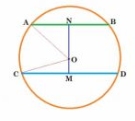
Proof: CD is a chord of circle and $OM \perp CD$
Thus, CM = MD = 5.5 cm (perpendicular from centre bisects chord)
and AN = NB = 2.5 cm
Let OM be x.
So, ON = 6 - x (MN = 6 cm )
In $\triangle$ OCM , using Pythagoras,
$OC ^2=CM^2+OM^2$ .............................1
and
In $\triangle$ OAN , using Pythagoras,
$OA ^2=AN^2+ON^2$ .............................2
From 1 and 2,
$CM ^2+OM^2=AN^2+ON^2$ (OC=OA =radii)
$5.5 ^2+x^2=2.5^2+(6-x)^2$
$\Rightarrow 30.25+x^2=6.25+36+x^2-12x$
$\Rightarrow 30.25-42.25=-12x$
$\Rightarrow -12=-12x$
$\Rightarrow x=1$
From 2, we get
$OC^2=5.5^2+1^2=30.25+1=31.25$
$\Rightarrow OC=\frac{5}{2}\sqrt{5} cm$
OA = OC
Thus, the radius of the circle is $\frac{5}{2}\sqrt{5} cm$
Answer:
Given : AB = 8 cm, CD = 6 cm , OM = 4 cm and AB || CD.
To find: Length of ON
Construction: Draw $OM \perp CD \, \, and \, \, \, ON\perp AB$
Proof :
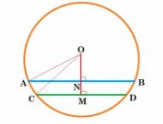
Proof: CD is a chord of circle and $OM \perp CD$
Thus, CM = MD = 3 cm (perpendicular from centre bisects chord)
and AN = NB = 4 cm
Let MN be x.
So, ON = 4 - x (MN = 4 cm )
In $\triangle$ OCM , using Pythagoras,
$OC ^2=CM^2+OM^2$ .............................1
and
In $\triangle$ OAN , using Pythagoras,
$OA ^2=AN^2+ON^2$ .............................2
From 1 and 2,
$CM ^2+OM^2=AN^2+ON^2$ (OC=OA =radii)
$\Rightarrow 3 ^2+4^2=4^2+(4-x)^2$
$\Rightarrow 9+16=16+16+x^2-8x$
$\Rightarrow 9=16+x^2-8x$
$\Rightarrow x^2-8x+7=0$
$\Rightarrow x^2-7x-x+7=0$
$\Rightarrow x(x-7)-1(x-7)=0$
$\Rightarrow (x-1)(x-7)=0$
$\Rightarrow x=1,7$
So, x=1 (since $x\neq 7> OM$ )
ON =4-x =4-1=3 cm
Hence, second chord is 3 cm away from centre.
Answer:
Given : AD = CE
To prove : $\angle ABC = \frac{1}{2}(\angle AOC-\angle DOE)$
Construction: Join AC and DE.
Proof :
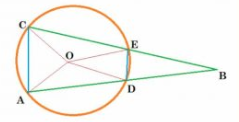
Let $\angle$ ADC = x , $\angle$ DOE = y and $\angle$ AOD = z
So, $\angle$ EOC = z (each chord subtends equal angle at centre)
$\angle$ AOC + $\angle$ DOE + $\angle$ AOD + $\angle$ EOC = $360 ^\circ$
$\Rightarrow x+y+z+z=360 ^\circ$
$\Rightarrow x+y+2z=360 ^\circ$ .........................................1
In $\triangle$ OAD ,
OA = OD (Radii of the circle)
$\angle$ OAD = $\angle$ ODA (angles opposite to equal sides )
$\angle$ OAD + $\angle$ ODA + $\angle$ AOD = $180 ^\circ$
$\Rightarrow 2\angle OAD+z=180 ^\circ$
$\Rightarrow 2\angle OAD=180 ^\circ-z$
$\Rightarrow \angle OAD=\frac{180 ^\circ-z}{2}$
$\Rightarrow \angle OAD=90 ^\circ-\frac{z}{2}$ .............................................................2
Similarly,
$\Rightarrow \angle OCE=90 ^\circ-\frac{x}{2}$ .............................................................3
$\Rightarrow \angle OED=90 ^\circ-\frac{y}{2}$ ..............................................................4
$\angle$ ODB is exterior of triangle OAD . So,
$\angle$ ODB = $\angle$ OAD + $\angle$ ODA
$\Rightarrow \angle ODB=90 ^\circ-\frac{z}{2}+z$ (from 2)
$\Rightarrow \angle ODB=90 ^\circ+\frac{z}{2}$ .................................................................5
similarly,
$\angle$ OBE is exterior of triangle OCE . So,
$\angle$ OBE = $\angle$ OCE + $\angle$ OEC
$\Rightarrow \angle OEB=90 ^\circ-\frac{z}{2}+z$ (from 3)
$\Rightarrow \angle OEB=90 ^\circ+\frac{z}{2}$ .................................................................6
From 4,5,6 ;we get
$\angle$ BDE = $\angle$ BED = $\angle$ OEB - $\angle$ OED
$\Rightarrow \angle BDE=\angle BED=90 ^\circ+\frac{z}{2}-(90-\frac{y}{2})=\frac{y+z}{2}$
$\Rightarrow \angle BDE+\angle BED=y+z$ ..................................................7
In $\triangle$ BDE ,
$\angle$ DBE + $\angle$ BDE + $\angle$ BED = $180 ^\circ$
$\Rightarrow \angle DBE +y+z=180 ^\circ$
$\Rightarrow \angle DBE =180 ^\circ-(y+z)$
$\Rightarrow \angle ABC =180 ^\circ-(y+z)$ ...................................................8
Here, from equation 1,
$\frac{x-y}{2}=\frac{360 ^\circ-y-2x-y}{2}$
$\Rightarrow \frac{x-y}{2}=\frac{360 ^\circ-2y-2x}{2}$
$\Rightarrow \frac{x-y}{2}=180 ^\circ-y-x$ ...................................9
From 8 and 9,we have
$\angle ABC=\frac{x-y}{2}=\frac{1}{2}(\angle AOC-\angle DOE)$
Answer:
Given : ABCD is a rhombus.
To prove: the circle drawn with AB as diameter passes through the point O.
Proof :
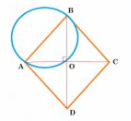
ABCD is rhombus.
Thus, $\angle AOC = 90 ^\circ$ (diagonals of a rhombus bisect each other at $90 ^\circ$ )
So, a circle drawn AB as diameter will pass through point O.
Thus, the circle is drawn with any side of a rhombus as diameter passes through the point of intersection of its diagonals.
Answer:
Given: ABCD is a parallelogram. The circle through A, B and C intersect CD (produced if necessary) at E.
To prove : AE = AD
Proof :

$\angle$ ADC = $\angle$ 3 , $\angle$ ABC = $\angle$ 4, $\angle$ ADE = $\angle$ 1 and $\angle$ AED = $\angle$ 2
$\angle 3+\angle 1=180 ^\circ$ .................1(linear pair)
$\angle 2+\angle 4=180 ^\circ$ ....................2(sum of opposite angles of cyclic quadrilateral)
$\angle$ 3 = $\angle$ 4 (oppsoite angles of parallelogram )
From 1 and 2,
$\angle$ 3+ $\angle$ 1 = $\angle$ 2 + $\angle$ 4
From 3, $\angle$ 1 = $\angle$ 2
From 4, $\triangle$ AQB, $\angle$ 1 = $\angle$ 2
Therefore, AE = AD (In an isosceles triangle ,angles oppsoite to equal sides are equal)
Q7 (i) AC and BD are chords of a circle which bisect each other. Prove that AC and BD are diameters
Answer:
Given: AC and BD are chords of a circle which bisect each other.
To prove: AC and BD are diameters.
Construction : Join AB,BC,CD,DA.
Proof :
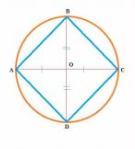
In $\triangle$ ABD and $\triangle$ CDO,
AO = OC (Given )
$\angle$ AOB = $\angle$ COD (Vertically opposite angles )
BO = DO (Given )
So, $\triangle$ ABD $\cong$ $\triangle$ CDO (By SAS)
$\angle$ BAO = $\angle$ DCO (CPCT)
$\angle$ BAO and $\angle$ DCO are alternate angle and are equal .
So, AB || DC ..............1
Also AD || BC ...............2
From 1 and 2,
$\angle A+\angle C=180 ^\circ$ ......................3(sum of opposite angles)
$\angle$ A = $\angle$ C ................................4(Opposite angles of the parallelogram )
From 3 and 4,
$\angle A+\angle A=180 ^\circ$
$\Rightarrow 2\angle A=180 ^\circ$
$\Rightarrow \angle A=90 ^\circ$
BD is a diameter of the circle.
Similarly, AC is a diameter.
Q7 (ii) AC and BD are chords of a circle which bisect each other. Prove that ABCD is a rectangle.
Answer:
Given: AC and BD are chords of a circle which bisect each other.
To prove: ABCD is a rectangle.
Construction : Join AB,BC,CD,DA.
Proof :
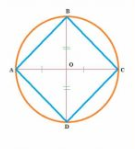
ABCD is a parallelogram. (proved in (i))
$\angle A=90 ^\circ$ (proved in (i))
A parallelogram with one angle $90 ^\circ$ , is a rectangle )
Thus, ABCD is rectangle.
Answer:
Given : Bisectors of angles A, B and C of a triangle ABC intersect its circumcircle at D, E and F respectively.
To prove : the angles of the triangle DEF are $\small 90^{\circ}-\frac{1}{2}C$ , $\small 90^{\circ}-\frac{1}{2}B$ and $\small 90^{\circ}-\frac{1}{2}A$
Proof :
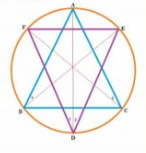
$\angle$ 1 and $\angle$ 3 are angles in same segment.therefore,
$\angle$ 1 = $\angle$ 3 ................1(angles in same segment are equal )
and $\angle$ 2 = $\angle$ 4 ..................2
Adding 1 and 2,we have
$\angle$ 1+ $\angle$ 2= $\angle$ 3+ $\angle$ 4
$\Rightarrow \angle D=\frac{1}{2}\angle B+\frac{1}{2}\angle C$ ,
$\Rightarrow \angle D=\frac{1}{2}(\angle B+\angle C)$
$\Rightarrow \angle D=\frac{1}{2}(180 ^\circ+\angle C)$
and $\Rightarrow \angle D=\frac{1}{2}(180 ^\circ-\angle A)$
$\Rightarrow \angle D=90 ^\circ-\frac{1}{2}\angle A$
Similarly, $\Rightarrow \angle E=90 ^\circ-\frac{1}{2}\angle B$ and $\angle F=90 ^\circ-\frac{1}{2}\angle C$
Answer:
Given: Two congruent circles intersect each other at points A and B. Through A any line segment PAQ is drawn so that P, Q lie on the two circles.
To prove : BP = BQ
Proof :

AB is a common chord in both congruent circles.
$\therefore \angle APB = \angle AQB$
In $\triangle BPQ,$
$\angle APB = \angle AQB$
$\therefore BQ = BP$ (Sides opposite to equal of the triangle are equal )
Answer:
Given :In any triangle ABC, if the angle bisector of $\small \angle A$ and perpendicular bisector of BC intersect.
To prove : D lies on perpendicular bisector BC.
Construction: Join BD and DC.
Proof :
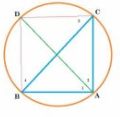
Let $\angle$ ABD = $\angle$ 1 , $\angle$ ADC = $\angle$ 2 , $\angle$ DCB = $\angle$ 3 , $\angle$ CBD = $\angle$ 4
$\angle$ 1 and $\angle$ 3 lies in same segment.So,
$\angle$ 1 = $\angle$ 3 ..........................1(angles in same segment)
similarly, $\angle$ 2 = $\angle$ 4 ......................2
also, $\angle$ 1= $\angle$ 2 ..............3(given)
From 1,2,3 , we get
$\angle$ 3 = $\angle$ 4
Hence, BD = DC (angles opposite to equal sides are equal )
All points lying on perpendicular bisector BC will be equidistant from B and C.
Thus, point D also lies on perpendicular bisector BC.
More About NCERT Solutions for Class 9 Maths Exercise 10.6
NCERT solutions Class 9 Maths exercise 10.6 incorporates some significant ideas from the past practices that might end up being essential to tackle a few varieties issues from NCERT solutions Class 9 Maths exercise 10.6
Equivalent chords of the circle subtend equivalent angle at the focal point (centre) of the circle
A perpendicular that is drawn from the centre point of the circle to the chord separates the given chord equally (divides the into two)
Assuming three non-colinear points are given in a plain, there is one and only one circle that goes through these points as a whole.
Aside from all the previously mentioned concepts the other way around of these theorems (hypothesis) are exceptionally basic in addressing some good questions.
Also Read| Circles Class 9 Notes
Benefits of NCERT Solutions for Class 9 Maths Exercise 10.6
Exercise 10.6 Class 9 Maths, is based on circles and the majority of the critical properties of circles.
From Class 9 Maths chapter 10 exercise 10.6 we get to revise and give a final touchup to the whole ideas of this part in a solitary exercise.
Understanding the concepts from Class 9 Maths chapter 10 exercise 10.6 will make the ideas and questions from better and competitive standards (like Class10) simpler for us.
Also, See
NCERT Solutions of Class 10 Subject Wise
Subject Wise NCERT Exemplar Solutions
Courses After 12th
Applications for Admissions are open.
As per latest syllabus. Physics formulas, equations, & laws of class 11 & 12th chapters
JEE Main Important Chemistry formulas
Get nowAs per latest syllabus. Chemistry formulas, equations, & laws of class 11 & 12th chapters
JEE Main high scoring chapters and topics
Get nowAs per latest 2024 syllabus. Study 40% syllabus and score upto 100% marks in JEE
JEE Main Important Mathematics Formulas
Get nowAs per latest syllabus. Maths formulas, equations, & theorems of class 11 & 12th chapters
